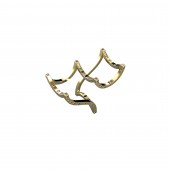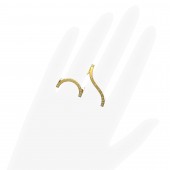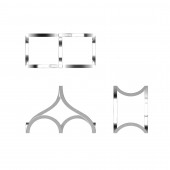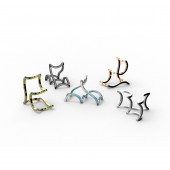
| THE AWARD |
| CATEGORIES |
| REGISTRATION |
| SUBMIT YOUR WORK |
| ENTRY INSTRUCTIONS |
| TERMS & CONDITIONS |
| PUBLICATIONS |
| DATES & FEES |
| METHODOLOGY |
| CONTACT |
| WINNERS |
| PRESS ROOM |
| GET INVOLVED |
| DESIGN PRIZE |
| DESIGN STORE |
| THE AWARD | JURY | CATEGORIES | REGISTRATION | PRESS | WINNERS | PUBLICATIONS | ENTRY INSTRUCTIONS |
Flowing Arcs Ring by Sun Hyang Ha |
Home > Winners > Design #31136 >Interview |
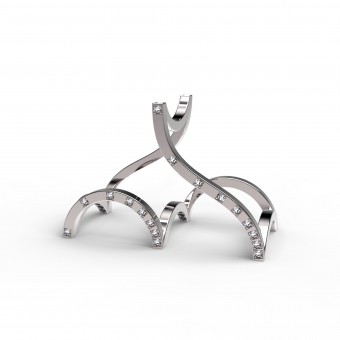 |
|
FS: What is the main principle, idea and inspiration behind your design?
SH: It is utilizing the feeling of continuity created by the illusionary movement of identical and basic geometric elements.
FS: What has been your main focus in designing this work? Especially what did you want to achieve?
SH: I wanted to design an unconventional ring that is not only functional but is also a beautiful objet d’art.
FS: What are your future plans for this award winning design?
SH: I would like to see a few pieces manufactured in two varieties: diamonds set in 18k gold and just in silver.
FS: How long did it take you to design this particular concept?
SH: It took me three days to sketch the design and make prototypes – first in aluminum and then in silver.
FS: Why did you design this particular concept? Was this design commissioned or did you decide to pursuit an inspiration?
SH: I designed the ring for a class project at my design school in Japan; the project required that the ring design not look like a ring.
FS: Is your design being produced or used by another company, or do you plan to sell or lease the production rights or do you intent to produce your work yourself?
SH: I would like to lease out the production rights for the ring.
FS: What made you design this particular type of work?
SH: I was interested in creating intriguing designs that made use of only basic geometric elements.
FS: Where there any other designs and/or designers that helped the influence the design of your work?
SH: I cannot name any design or designer specifically. However, I am fond of Scandinavian designs, which are simple and sleek, and they may have influenced my style.
FS: Who is the target customer for his design?
SH: Anyone who likes unconventional jewelry would be a target customer.
FS: What sets this design apart from other similar or resembling concepts?
SH: Whereas most double finger rings have two adjacent round shanks and must be worn on two fingers, this ring is not circular and can be worn on both one as well as two fingers.
FS: How did you come up with the name for this design? What does it mean?
SH: I chose the name Flowing Arcs for this design, as it makes use of only arcs that flow in a line from one to the other.
FS: Which design tools did you use when you were working on this project?
SH: I made the prototypes in metal using jewelry tools. For the presentation, I refined the design using a CAD program.
FS: What is the most unique aspect of your design?
SH: It is the fact that although it is a ring, it does not look like one.
FS: Who did you collaborate with for this design? Did you work with people with technical / specialized skills?
SH: I worked entirely on my own.
FS: What is the role of technology in this particular design?
SH: Only to the extent that I have used CAD/CAM programs for simulating the design in different materials.
FS: Is your design influenced by data or analytical research in any way? What kind of research did you conduct for making this design?
SH: I have not made use of any kind of research while developing this design.
FS: What are some of the challenges you faced during the design/realization of your concept?
SH: I started the design using only straight lines. However, since the ring was not circular like other rings, it slipped off when it was worn on one finger. Playing with prototypes, I finally discovered that two arcs on opposite sides could securely hold the ring in position. Thus, I replaced the straight lines with arcs.
FS: How did you decide to submit your design to an international design competition?
SH: While I mostly design classic fine jewelry, I liked this design and did not want to leave it lying around, discarded as an old class project.
FS: What did you learn or how did you improve yourself during the designing of this work?
SH: It taught me how I can always turn to very simple elements to find a way forward, whenever I am unable to come up with a design.
FS: Any other things you would like to cover that have not been covered in these questions?
SH: I just want to say thank you for the opportunity.
FS: Thank you for providing us with this opportunity to interview you.
A' Design Award and Competitions grants rights to press members and bloggers to use parts of this interview. This interview is provided as it is; DesignPRWire and A' Design Award and Competitions cannot be held responsible for the answers given by participating designers.
| SOCIAL |
| + Add to Likes / Favorites | Send to My Email | Comment | View Press-Release | Translations |
